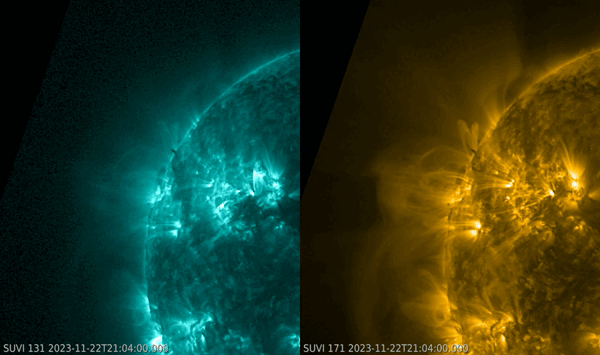Starting on 18 November, a nest of sunspots started to round the Sun's northeast limb. It concerned a conglomerate of 5 sunspot groups cramped into an area of 15 by 20 degrees, as sardines in a can. This sunspot nest was then followed by a string of sunspot groups in the southern hemisphere nicely following one after the other. The white light image underneath was taken with the solar telescopes of the Royal Observatory of Belgium (ROB/USET) showing the solar disk on 23 November around noon.

The daily estimated sunspot number (SILSO) increased from around 30 on 18 November to nearly 200 on 23 November, as shown by the blue curve in graph underneath. Its twin, the 10.7cm radio flux (Penticton), followed suit and increased from its lowest value so far this year (118 sfu on 16 November, with sfu short for "solar flux unit") to a high 194 sfu on 23 November. The sharp increase was also recorded for other solar parameters, such as the average soft x-ray background solar flux which more than tripled in value in just a few days, from B7 to C2 (red curve; it uses the same scaling as solar flares). In other words, the entire Sun started to emit three times as much soft x-ray radiation than only a few days earlier.

Extreme ultraviolet (EUV) images such as from SDO/AIA, GOES/SUVI and PROBA2/SWAP also showed an impressive facelift of the solar disk as the active regions gradually conquered the solar hemisphere visible from the Earth. This can be seen in the SDO images underneath. For 17, 20 and 23 November, white light (top row) and EUV (AIA094 filter, at multi-million degrees; bottom row) images show the change in outlook of the Sun as it evolves from a dim and quite featureless appearance into a complex disk with many bright active regions.

Despite all those sunspot groups, the flaring activity was limited to C-class flares and only 4 (four!) low-level M-class flares. The strongest one a was a long-duration M1.4 flare that peaked on 23 November at 03:38UTC. Its source was behind the northeast limb and as such not related to the sunspot nest that was already approaching the central meridian. The eruption apparently destabilized other areas on the Sun, resulting in the ejection (in two phases) of a filament at the northeast limb starting from around 05:30UTC onwards. The clip underneath shows the Sun in multi-millions degrees (GOES/SUVI 131) on the left and at slightly "cooler" temperatures near 700.000 degrees (GOES/SUVI 171) on the right. The post-eruption coronal loops towered nearly 150.000 km above the solar limb, and the ejected filament material could be traced through the entire field of view of SUVI more than 450.000 km away from the Sun. Both the farside event as the filament eruption were associated with separate coronal mass ejections, but none of those had an earth-directed component.
